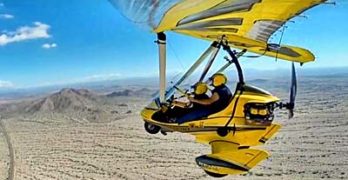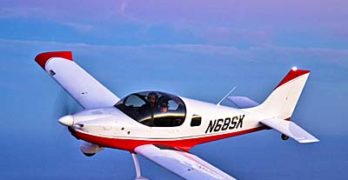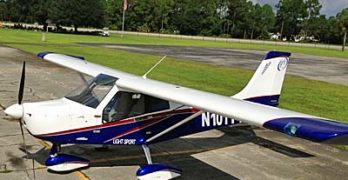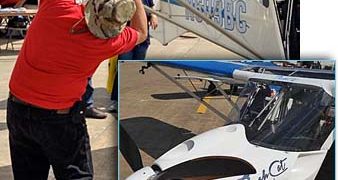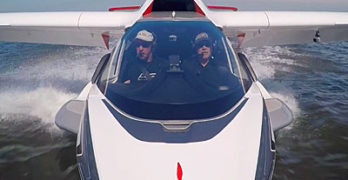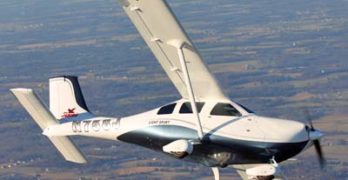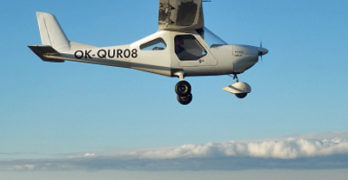Sometimes I am pretty darn sure I may have the best job in the world, or at least one of the best jobs. Other times, it seems like work, as does any job. However, when it’s good, it can be ecstatically great, no question about it. One time I know this is the case is when I get to go aloft in a truly great flying machine with an excellent instructor or demo pilot to explain their aircraft and show me how to optimize the machine.
Such was the situation when I got to fly the Evolution Trikes Revo with Larry Mednick at the Arizona Copperstate show in October 2015. We hadn’t been to this event for some time and mid-fall in Casa Grande demonstrated why they hold it then.
I grew up in the desert and to this day, I find that landscape beautiful. I love green trees covering granite mountains, or ocean views, but the Arizona desert is simply stunning to my eyes.
Search Results for : CT AND hand control
Not finding exactly what you expected? Try our advanced search option.
Select a manufacturer to go straight to all our content about that manufacturer.
Select an aircraft model to go straight to all our content about that model.
Santa Sleigh Flight Operation … Read the Manual!
As we near Christmas time and as children around the globe await the arrival that busy flyer, Santa Claus, did you ever wonder how the big man in the red flight suit manages the effort, specifically how he preflights the sleigh and controls his “engines?”
So far as we know, he only flies the reindeer-powered sleigh once a year. How do you maintain your flying skills with a single flight per year? OK, he probably flies locally around the North Pole doing touch and goes but apparently no one ever sees it happen. A better guess is that, like any good pilot, he reviews his Sleigh Pilot Operating Handbook before getting into his busy season.
You didn’t really think it was some magical occurrence, did you? Come on … you’re a pilot, no doubt a very good one. Would you go fly your airplane — or for that matter, your sleigh, assuming you were some rather chubby but jolly fellow with a snowy white beard — without first giving your sleigh a thorough check?
Lightweight Autopilot from TruTrak & Levil
In 2004, when the SP/LSA regulation was announced, who would have forecast that on light aircraft, autopilots would be a common feature. Such gear seemed fanciful as autopilots were costly, rather heavy, a maintenance hassle … and besides, weren’t you supposed to “hand fly” a light aircraft so you could truly enjoy flight? Is punching a button to take over the flying chores what we wanted to do?
In nearly a dozen years since FAA’s reg established aviation’s newest and fastest-growing sector, autopilots have become common. Much as I love hand flying, winging about the sky, if I am traveling somewhere and especially if I really need to pay sharp attention to radio work and staying precisely on course — for example, to avoid hot MOAs or Class B airspace — an autopilot can be a mighty handy feature. What used to be way expensive and heavy has changed dramatically and one company had a lot to do with that change: TruTrak.
Aircraft of Copperstate 2015 Continued (Part 2)
In this Copperstate Part 2 article we resume the list of aircraft Videoman Dave and I reviewed at the show south of Phoenix, Arizona in Casa Grande. To remind you, this was the 43rd running of this show that invites all sorts of aircraft — and many dozens did fly in each day plus others did fly-over demonstrations.
However, Copperstate generates a particularly strong response from manufacturers and representatives of Light-Sport Aircraft, light kit aircraft, and utralights. That makes it a must-go show for our team at ByDanJohnson.com and Dave’s SportAviationMagazine.com YouTube channel that so many of you seem to enjoy.
Like other shows, many of you approached us at the event and expressed your ongoing interest in the video content we create. We are very pleased about your loyal viewership and will continue to work hard to build our growing video library … already at 400+ videos and moving steadily to 500 and beyond.
Flying a Sling Taildragger in America
Light-Sport Aircraft comprise an diverse gaggle of some beautiful airplanes. Choices are available in a dizzying array of configurations and variations. In fact, so many selections are available to you (as Special LSA) that I created PlaneFinder 2.0 to help folks narrow the decision to a few that might best suit your needs, interests, experience, and budget.
If you haven’t checked out this cool feature, you should do so. You can click on and off more than 20 different aircraft characteristics, all simple yes-or-no type entries. As you do so, the “Matching List” changes to show the aircraft that meet your criteria. From that list you’ll see links that let you read more content (written and video) available on this website. You must register to use PlaneFinder 2.0 (your email is all that is required and after you do so we’ll send you a regular English-word password that you can change), however, PlaneFinder 2.0 is completely free, like most of our content.
Going Aloft in Paradise Aircraft’s New P1NG
Yes, they call it “Ping” among themselves but it is actually P1 NG, as in Next Generation. “Ping” has a few American user-friendly changes from the earlier P1 brought about by comments from U.S. representatives of the Brazilian design.
I’ll get into the aircraft changes in a moment but first let me remind you what Paradise Aircraft has done. The brand is well established in the southern hemisphere country where they manufacture a line of two and four seat aircraft. These designs have found favor with Brazilian farmers some of whom operate vast operations that are distant from the population areas so they use aircraft to manage their enterprises.
If you’ve followed the news, you may know the natural-resources-rich Brazil has experienced an economic decline as commodity prices have fallen, driven heavily by China’s pullback on those purchases while its economy cools. The government of Brazil did not keep up with the changing times and current president Dilma Rousseff is suffering from very low approval ratings.
The Age of YouTube & Video Pilot Reports
When this website went live a few months before the Sport Pilot & Light-Sport Aircraft rule was announced at Oshkosh 2004, it began life as an archive of several hundred pilot reports I had written for a number of print magazines in aviation. That launch seems a long time ago … it has been eleven and a half years. (Development started only a few years after the World Wide Web emerged and ByDanJohnson.com went live in April 2004.)
One year after going live, I began to add news via a blog, which I called “Splog,” for Sport Pilot web log. Videos started in 2008 and by 2015, news and video have become the primary content items.
You might be surprised to hear ByDanJohnson.com predates YouTube, which began when three former PayPal employees created a video-sharing website. The Internet domain name YouTube.com was activated on February 14, 2005 and the website went public in November of that same year.
DemoVenture 2015 — Flying at Oshkosh
Shows like Sebring and Midwest LSA Expo are known for being great places to demo fly a Light-Sport or light kit you may be considering to buy. They earned that reputation because it is typically much easier to fly at those lower-key, less crowded events than at giant shows like AirVenture. However, some companies make demo flying a mission at Oshkosh and this article covers three that delivered an exceptional number of demo flights.
Icon reported doing around 150 demonstration flights in the first public outing of the long-awaited LSA seaplane. Writers for aviation’s largest magazines got their private crack at the new bird beforehand … since returning from Oshkosh, I’ve seen A5 on the covers of Flying, AOPA Pilot, Sport Aviation, and Plane & Pilot. That’s an enormous splash. I can’t recall any single aircraft capturing all four titles in the same month, quite a credit to Team Icon for deftly executing such a major marketing push.
AirVenture Previews Continue as Opening Day Nears
We and many other journalists have arrived in EAAworld and are gearing up for another big event. Here are two aircraft announcements of interest and one avionics offering. More will follow.
Jabiru USA has news prices and new gear for their speedy line of kits and LSA. Jabiru USA Sport Aircraft is celebrating ten years in the Light-Sport Aircraft market by offering a new large-screen Garmin G3X Touch avionics package as standard equipment for its J230-D high-performance composite LSA while lowering the price of the fully-loaded aircraft to $119,900. The Australian-designed Jabiru J250/230 series has been flying in the U.S. since 2005 and is known for its speed, easy handling and large baggage capacity.
“By simplifying our overhead, we are now able to offer the new fully-equipped J230-D with the Garmin system for $119,900, a price cut of nearly $20,000,” said Jabiru USA general manager Pete Krotje.
PSA: An Affordable Aircraft?
The following article is a guest editorial by Chip Erwin, a name many rightfully associate with the highly successful SportCruiser LSA. A restless entrepreneur, Chip has been working behind the curtain for several years. He emerged with the Zigolo and is now proposing a fresh name for a segment that seems to have energy behind it. I have reported on England’s new SSDR 300 category and I have observed the rejuvenation of Part 103 vehicles. So, on our recent travels to China, I encouraged Chip to express what he has in mind.
Article Update 6/15/15 — At the end of this article see our video shot at Sun ‘n Fun 2015 regarding Chip’s electric motor and plans.
Is “affordable aircraft” an oxymoron? For most people, probably yes. One answer could be a class of aircraft I like to refer to as a PSA, or Personal Sport Aircraft.
- « Previous Page
- 1
- …
- 29
- 30
- 31
- 32
- 33
- …
- 62
- Next Page »


